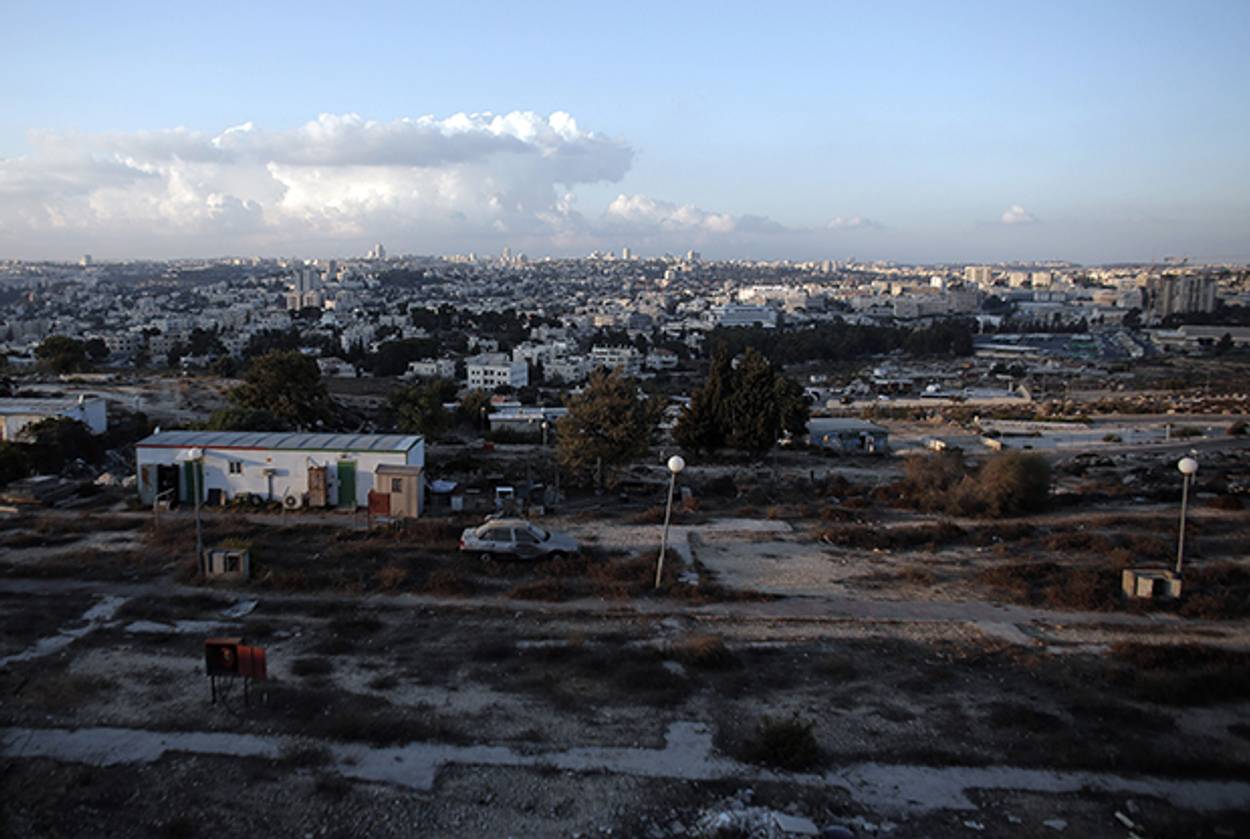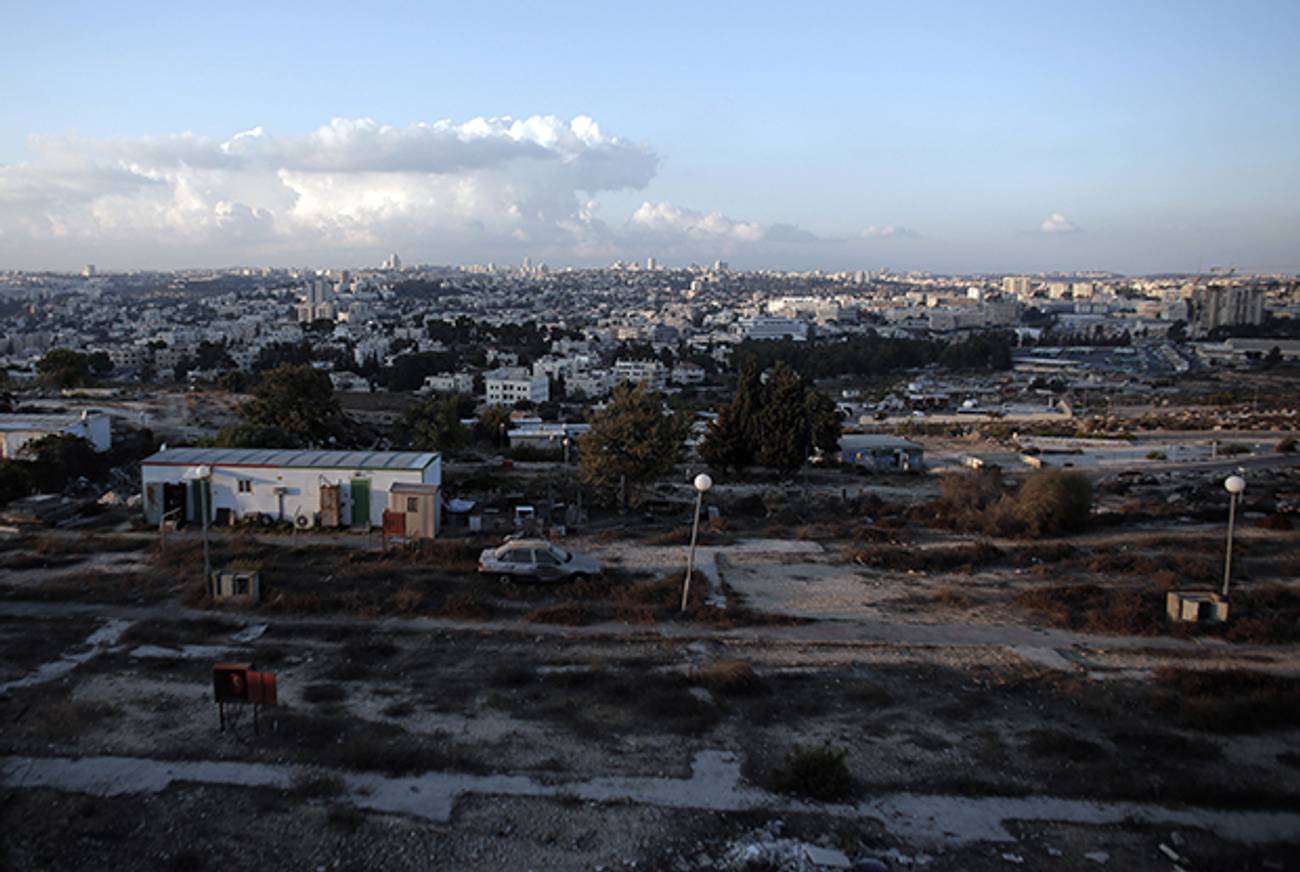Jerusalem Through Its Mayor’s Eyes
Nir Barkat leads foreign journalists on a telling tour of East Jerusalem




It’s back to business as usual in Jerusalem, at least according to the city’s mayor, Nir Barkat. The intifada that’s been brewing since last summer? Mostly kids skipping class. “Over the past six months, we’ve had riots, mostly by teenagers, and we’ve worked very hard to return the kids to school,” Barkat told reporters Sunday. “Unfortunately they weren’t listening to their parents and teachers. Today, ninety-five percent of them are back in school. We’ve been working with local leadership, and the trend is very positive. There’s been a dramatic decrease in violence in the Arab neighborhoods.”
Nir Barkat is one year into his second term as mayor of Jerusalem. It’s surely been his most difficult year on the job, with the surge of violence beginning with the murder of Palestinian teen Mohammed Abu Khdeir by Jewish terrorists, an act of revenge for the kidnapping and killing of three young Israelis in Gush Etzion. The ensuing Israeli operation against Hamas in Gaza brought with it almost daily incidents of stone throwing and Molotov cocktails in Jerusalem. The city’s new light-rail system, touted as a symbol of the city’s coexistence as it weaved its way between Jewish and Arab neighborhoods, was shut down repeatedly by rioting, and then targeted twice by Palestinian drivers plowing through the station. The murderous Nov. 18 attack on a Jerusalem synagogue was the latest, and most horrifying, event. But the past few weeks have been relatively quiet.
Barkat was speaking with members of the foreign press while leading them on a tour through “neighborhoods on the seam.” Those are neighborhoods the foreign press would be more likely to call the Jewish and Arab neighborhoods of East Jerusalem—just outside the 1967 boundaries, firmly within the Jerusalem municipal boundaries. It was, among other things, a tour of places whose names have become familiar through recent building announcements.
We began in Ramat Shlomo. A mostly ultra-Orthodox neighborhood of about 20,000 people, Ramat Shlomo is located north of the Green Line. A March 2010 announcement of the construction of 1,600 new apartments in the neighborhood caught U.S. Vice President Biden during a visit to Israel. Biden called it “precisely the kind of step that undermines the trust we need right now” (the tour ended, sans Barkat, at Givat Hamatos, another controversial site).
Driving through Ramat Shlomo, though, it’s difficult to see what all the fuss is about. It looks like any other Haredi neighborhood in the city. Among its few highlights are a full-scale reproduction of the Chabad-Lubavitch World Headquarters at 770 Eastern Parkway in Brooklyn and an ancient quarry, the stones of which were used in the construction of the Second Temple. Ramat Shlomo’s dullness was essentially the point. Barkat used it as a backdrop to present his “Jerusalem Master Plan 2000,” detailing how the city intends to scale from 800,000 to 1 million residents. The maps he presented did not have the Green Line on them, only Jerusalem’s municipal borders, and were filled with orange blotches designating planned construction. There was no indication whether the construction was intended for Jews or Arabs. That, too, seemed intentional. In fact, Barkat said, it was none of the mayor’s business who lives where.
“City planning here is still governed by old British law,” Barkat explained. “It requires a lengthy committee process and leaves no room whatsoever for discrimination.” Since he’s not allowed to discriminate, “the alternative is not building altogether, for both Jews and Arabs,” he added. “Should I ask people if they’re Jewish or Muslim before I let them build? God forbid! So it’s either we freeze completely or discriminate, God forbid. Those alternatives are insane.”
Another recent point of contention with the international community has been the purchase of apartments in Arab neighborhoods by Jews, often through elaborately veiled business deals so as to disguise the identity of the buyers. Thus, Jewish enclaves are effectively created in the heart of Palestinian neighborhoods. Barkat thinks private people have the right to live wherever they choose. “Jews prefer to live in Jewish neighborhoods, and Arabs in Arab neighborhoods,” he said. “But there are more Arabs living in Jewish neighborhoods than the other way around—and the Arabs don’t need protection when they do so.”
We drove out of Ramat Shlomo, down a new road leading into Shuafat, where Mohammah Abu Khdeir was kidnapped and killed in July. “You heard on the news that there was a bit of stone throwing here,” Barkat said. The main stretch of Shuafat has calmed down, but border police still line the street corners, and there is litter everywhere. The mayor pointed out the spot where Abu Khdeir was abducted.
We parked by a brand new girls’ school in nearby Beit Hanina, probably the most affluent Palestinian neighborhood in the city. Barkat is very proud of the new classrooms the municipality built in both Jewish and Arab schools. It was, admittedly, a nicer building than most of the Jewish schools I’ve been to. Even though it was Sunday and the students were off from school, dozens of them had shown up for extra lessons in math and science. The mayor chatted with the girls in English.
I challenged Barkat on his earlier point. The Arabs who live in Jewish neighborhoods do so because of the better quality of life. The Jews living in Arab neighborhoods, it seems, do so because they wish to change the very nature of the place–to turn the village of Silwan back into the City of David that it was some 3,000 years ago. If an Islamist movement were to try and turn Jewish Rehavia into an Arab neighborhood, presumably the Shin Bet would be all over them.
Barkat wouldn’t budge. “Who has a right to tell anyone where to buy and sell? They’re doing so privately,” he countered. “I think Jews should be able to live anywhere in the world–Amman, Beirut, New York, and of course in Jerusalem. Suggesting otherwise is an absurd notion, and I dismiss it.”
Barkat runs one of the most difficult cities in the world. Simple demographic calculus suggests that any movement to the Left would spell his political demise (the Arab residents of the city, as a rule, do not exercise their voting right). If Prime Minister Benjamin Netanyahu loses the upcoming March election, Barkat is a prime contender for national leadership of Israel’s right wing. Under such a scenario, his chief competitor would be Naftali Bennett, another successful combat officer turned businessman turned public figure. But Barkat’s achievements in combat and business dwarf Bennett’s, and the successful turnaround he’s effected in Jerusalem–provided things stay as quiet as they’ve been recently–speaks for itself.
As I wrote of Barkat prior to last year’s elections, he has a knack for glossing over the city’s complex national politics, and treating it like the living, breathing city it is. I was always skeptical of this approach, and this past summer vindicated my skepticism. But for now, Barkat’s approach seems to have won out yet again.
“I’m totally committed to all residents here,” he said Sunday. “Regardless of religion, regardless of whether they vote for me or vote at all–they are all my children and I take care of all of them.”
Related: How Nir Barkat’s Lack of Poetry Brought Jerusalem Back From the Dead
Taken For a Ride in Jerusalem
Tal Kra-Oz is a writer based in Tel Aviv.